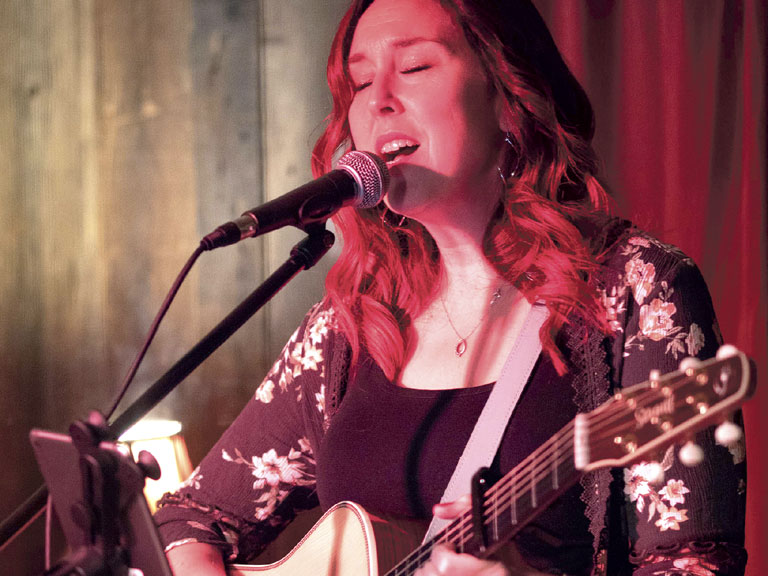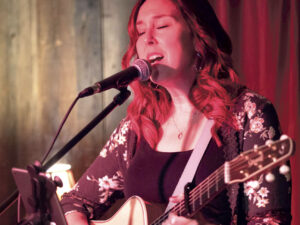County News
Fresh air

Karlo Estates brings music indoors
Over the past few months, the outdoor music program at Karlo Estates has proven very popular. Local musicians got an opportunity to play in front of an audience, and patrons were able to listen to live music while enjoying a glass of County wine and some tasty snacks. About two months ago, Sherry Karlo and partner Saxe Brickenden began to think about how they might be able to move the music indoors. On the outdoor stage the musician had to be at least 15 feet away from the audience; indoors the musician would have to play from behind a Plexiglas screen. The inside wine lounge is naturally sectioned into a number of smaller areas, and Karlo and Brickenden realized these could be curtained off to provide some separation between people in different “bubbles”. With the curtains closed, patrons inside need not wear a mask as the room itself is essentially masked. Brickenden had the idea that the Plexiglas-enclosed area be kept at negative pressure, so that any aerosols produced by the musician would be ventilated to a purification system, rather than circulating in the lounge. In a flash of inspiration, Karlo came up with another way to keep everyone safer. “Sherry’s innovation was to treat each area like a hospital room. We want each of the rooms to be autonomous from a ventilation standpoint,” says Brickenden. This meant that each area had to have its own inflow and cold air return, with the musician area having slightly larger ducting to maintain negative pressure. “Nobody’s air is mixing with anyone else’s air, so now you have your own bubble of air that’s being filtered and sterilized and removed,” explains Karlo.

Deborah Lynn performs from behind a Plexiglass screen at Karlo Estates wine lounge.
It was a complex and expensive change, with the contractor describing it as a spaghetti of ductwork. “The cold air return goes through the best purification system we’ve got, and one that is widely used in hospitals. There’s ultraviolet and a HEPA filter that exponentially drops the number of potential COVID viruses in the space. This is the new reality. We want to be the safest fun space in the County, so that means we’re going to have to use technology, not just wait for things to change,” says Brickenden. Having a new ventilation system is one thing; ensuring that it does the job is another, and this is where an air quality sensor designed by Alan Majer of AirQ.ca comes in. Majer has been working at the intersection of business and technology after graduating with a Master’s degree in business. He worked for more than a decade in a think tank run by Don Tapscott before starting his own business to look at devices in the home that could be connected to the Internet of things, and then he started making prototype devices for start-up companies. When the COVID-19 pandemic struck, he began to think about how the virus spreads, and he realized that lingering exhaled air could be a good indicator of risk. He first used commercially available carbon dioxide (CO2) sensors to detect exhaled air, but soon realized he had to make his own sensors to detect particles in the air as well. “I had to do a lot of research into what is the relevant particle size. As particles get around under 10 microns, they can stay in the air for minutes or even hours. Our particle sensor measures that 10 micron category, which is really a key factor for spread. The particle sensor does not detect COVID within the air. What it is useful for is understanding how good your filtering system is. You measure the intake of the filtering system and you measure the air it’s putting out and look at the difference. All the data is logged and you can see how it changes with time. The more fresh air you are bringing into a space, the less chance you have stale exhaled air hanging around, and really that’s how COVID spreads, one person breathing in another person’s exhaled air,” says Majer.
Majer’s device is palm sized and a couple of centimetres thick. It continuously measures the air quality in Karlo’s wine lounge and early indications show the new ventilation and purification system is removing almost all the small particles. In addition the UV system kills over 90 per cent of airborne viruses. “You can feel safe here. There’s great quality air and a team looking after you with COVID protocols and great hospitality,” says Karlo. The winery is only advertising to locals, and only using local musicians within the space, factors that are important as COVID-19 cases are very low here. “We want to make sure if we are asking people to come inside, they are in the safest space possible,” says Karlo. As always, there’s no cover charge for music nights in the lounge. Although the lounge has a nominal capacity of 50 people, typically there are no more than 25 in total at any given time. But Karlo and Brickenden are considering ways to give people the Karlo experience at home. “We’re looking at live-streaming the music, so we can share this great Canadian content with our neighbours and with people who can’t come to the County right now. They can order wine online, they can get a curated charcuterie box from us and turn on great Canadian music, and have the Karlo experience from the comfort of their own home,” says Karlo.

Comments (0)